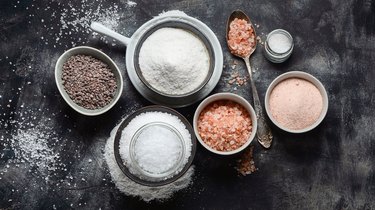
It's funny how rumors get started and then passed around as fact — like how George Washington had wooden teeth. While not as widespread, claims about Himalayan salt nutrition aren't true either. There are trace amounts of minerals, but it's impossible to know how many.
Facts About Himalayan Sea Salt
Video of the Day
Whether because of its attractive pink color or some strategic marketing — or both — Himalayan pink salt has become a staple in spice racks around the country. You can also find it in beauty treatments and lamps. But what is it and where does it come from?
Video of the Day
Surprisingly, most Himalayan pink sea salt comes from Pakistan, not from the eponymous mountain range, reports NPR News. To be exact, it is mined from the salt range in the city of Khewra from hills above what was once a lagoon 600 million years ago. These hills are located hundreds of miles from the Himalayas.
Besides its color, pink "Himalayan" sea salt isn't vastly different from any other kind of sea salt. It may have a different color and texture and a slightly different flavor, but nutritionally, it's nearly identical to the plain old white stuff. According to the Iodine Global Network, the claims about Himalayan salt benefits come directly from the Khewra Salt Mine itself. These claims have not been validated by the scientific community.
Read more: 10 Myths About Salt Debunked
Himalayan Salt Nutrition
Many people mistakenly believe that Himalayan sea salt is lower in sodium than regular salt and a rich source of trace minerals, such as magnesium, potassium and calcium. In fact, according to the USDA nutrition database, gram for gram, pink sea salt contains almost the same amount of sodium as table salt.
The other misconception is that Himalayan sea salt — and sea salt in general — is healthier than table salt because it is less processed. Table salt, which is mined from underground salt and mineral deposits, undergoes processing to remove impurities and trace minerals. An anti-caking agent is then added to it, in addition to the mineral iodine.
Iodine is a crucial mineral that the body does not produce, so it must be obtained from the diet. The thyroid gland requires iodine to make thyroid hormones that are responsible for many physiological functions, including growth and development. Iodine deficiency in pregnant woman is a worldwide public health issue, and the preeminent cause of brain damage in babies, according to the Academy of Nutrition and Dietetics.
Sea salt may contain iodine, but it is not a reliable source. The World Health Organization recommends that all salt that is consumed be iodized, or fortified with iodine.
As for other minerals in Himalayan sea salt, while they are present in greater amounts than table salt, the amounts are minuscule, according to McGill University's Office for Science and Society. Minerals are plentiful in both plant and animal foods, which serve as much better sources than sea salt.
The Skinny on Sodium
Americans consume way more sodium than they should. According to the American Heart Association, adults in the U.S. eat more than 3,400 milligrams of sodium each day — more than double the AHA's recommended daily limit of 1,500 milligrams. Excess sodium raises blood pressure and increases the risk of heart disease and stroke.
Although only approximately 10 percent of sodium in the diet comes from home cooking, using less salt in food preparation is one step towards reducing your sodium intake. It doesn't matter whether this is table salt, pink Himalayan sea salt or any other kind of salt — less is more when it comes to your health.
Keep in mind that 1 teaspoon of salt provides 2,300 milligrams, so use it sparingly. If you typically eat a lot of heavily salted foods, your taste buds have become accustomed to the flavor. If you reduce the salt in your cooking gradually, over time you will begin to notice that you become more sensitive to the flavor and don't need nearly as much.
- George Washington's Mount Vernon: "Wooden Teeth Myth"
- NPR: "Pakistan Wants You To Know: Most Pink Himalayan Salt Doesn't Come From India"
- Iodine Global Network: "Iodized Salt or Sea Salt: Which Is Better for You?"
- USDA: "Pink Sea Salt"
- USDA: "Table Salt"
- Academy of Nutrition and Dietetics: "Iodine, a Critically Important Nutrient"
- American Heart Association: "9 out of 10 Americans Eat Too Much Sodium Infographic"
- American Heart Association: "Shaking the Salt Habit to Lower High Blood Pressure"
- World Health Organization: "Salt Reduction"
- McGill University Office for Science and Society: "Is Himalayan Pink Salt Better For You?"